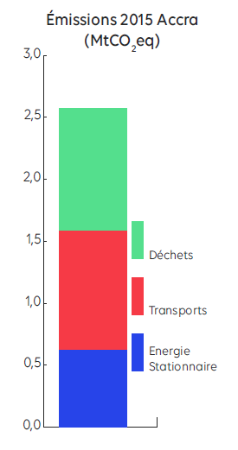Accra - Towards carbon neutrality by 2050
Assessment of the territories’ climate action
2018
Association Climate Chance (Climate Chance)
Since 2015, the Climate Chance Association has been involved in the mobilization in the fight against climate change. It is the only international association that proposes to bring together on an equal footing all non-state actors recognized by the UN. In order to strengthen their action and to give credibility to the climate stabilization scenarios, the Climate Chance Association launched in 2018 a Global Observatory of Non-State Climate Action, which aims to explain the evolution of greenhouse gas emissions, by crossing national public policies, with sectoral dynamics, private actors’ strategies, local public policies and actions undertaken by local actors. In order to analyse the coherence of local public policies, Climat Chance proposes an assessment of « territorial mobilisations » through selected examples of cities and regions. Here, Accra.
To download : book_2_2018.pdf (820 KiB)
Accra’s GHG emissions were about 2.57 MtCO2 in 2015, or less than one tonne per capita, well below the world average (C40). These emissions are due to waste (38.5%), transport (37%) and stationary energy (24%). The Accra Metropolitan Assembly (AMA) has been committed for several years to a climate-compatible development approach and has, in this respect, joined several city networks, since 2009 the C40 and more recently the Covenant of Mayors in Sub-Saharan Africa.
PIONEER CITY IN WEST AFRICA ON MITIGATION

Accra shows a strong will to make the city an example to follow in West Africa :
-
Accra has been disclosing its climate data to the PGB since 2016, demonstrating its ability to collect and aggregate data, a major challenge in many African territories. To this end, the municipal teams have benefited from capacity building on MRV (Measurement, Reporting Verification) systems and in particular the production of emissions inventories ;
-
At COP23, Accra committed itself to implementing an ambitious climate action plan by the end of 2020 and to presenting a carbon-neutral balance sheet by 2050 ;
-
In August 2018, the city was the first metropolis in Africa to join the global Breathe Life campaign to reduce air pollution.
A COMMITMENT TO CARBON NEUTRALITY TO BE MADE CONCRETE
The commitment to carbon neutrality has not yet been translated into an action plan, but since May 2018, the city has been supported by the C40 Climate Action Planning Africa Programme (financed by the International Climate Initiative - ICI).
-
IKI). This programme, which supports 9 African cities in the development of climate plans aligned with the Paris Accord, will include the organisation of workshops and the provision of a dedicated local advisor over the next 3 years.
A first workshop, held in September 2018, brought together several WADA departments, national representatives (including the Environmental Protection Agency) and civil society around the definition of prospective development scenarios for the metropolis. The workshop was an opportunity to recall that the fight against climate change would also improve the living environment of the population and that close collaboration with the national level was necessary. This is all the more true since, with a population of nearly 2 million inhabitants (2015) and 4 million in the Greater Metropolitan Area, the Accra region concentrates a large part of the Ghanaian population and economy.
ADAPTATION STRATEGIES TO BE STRENGTHENED
Accra regularly suffers from floods which sometimes have disastrous consequences in human terms with the development of epidemics. The lack of protection and care infrastructures and the high population density make the challenge of climate change an important one. However, the city does not have a specific adaptation strategy at this stage and is sticking to the National Adaptation Strategy (NCCAS). A member of the 100 Resilient Cities network since December 2014, the city published in March 2018 a diagnosis of its resilience, which goes beyond climate alone, and is preparing to develop its resilience strategy on this basis. It establishes that the greatest sources of stress for the population are the cost of living, inefficiency of public transport and waste management, and that the major shocks to which the city is subject are floods first, followed by fires and epidemics.